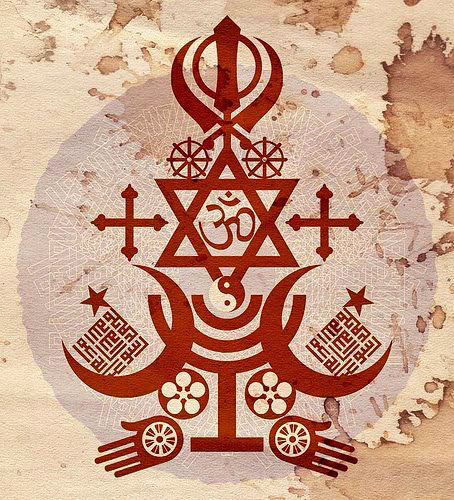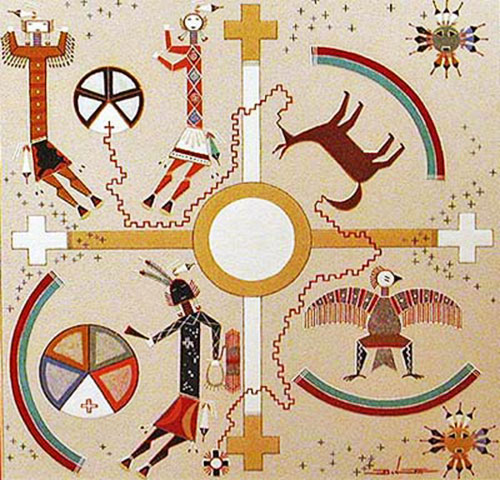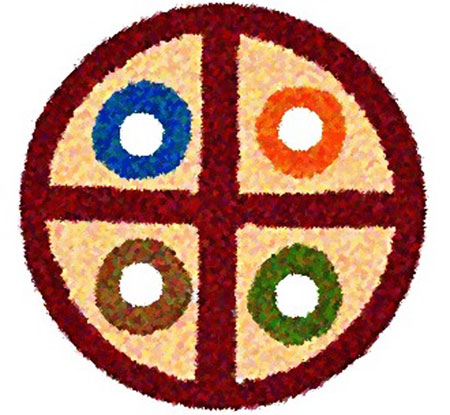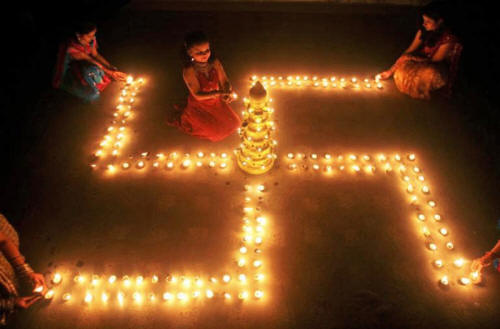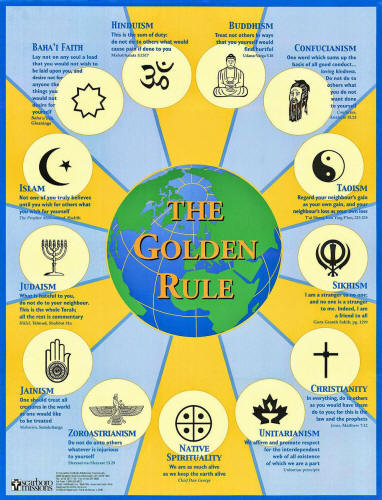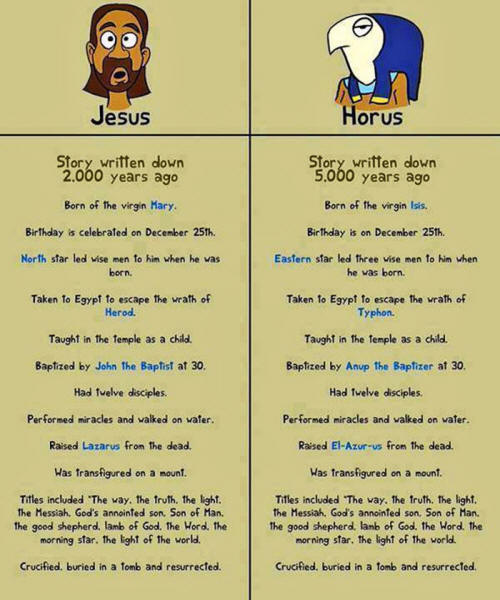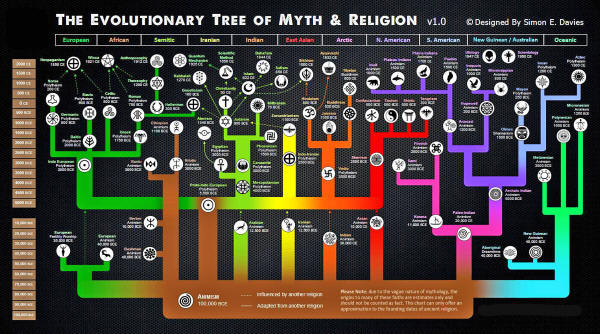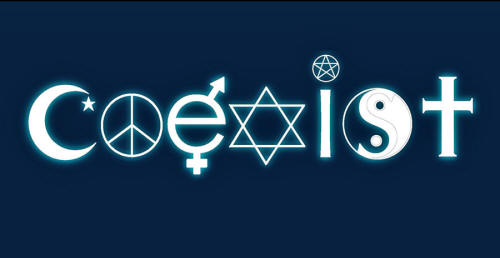|
from Wakeup-World Website
The Brotherhood of
Man
This is verified biologically of course,
but perhaps more importantly for our understanding of one other, the
brotherhood of man is verifiable in our belief systems, in our
spiritual ideas that are upriver from the rest of our thinking, and
our creation stories from which stems our very concept of existence.
And although many people frequently get
caught up with the difference of the feather rather than the
similarity of the bird, so to speak, the common origins of religions
and their central tenets is proof that - despite varying 'faiths' -
we are more alike than we are different.
The very inquiry into the origins of human nature is typically posed through such a limited mindset:
In reality, to consider any information or situation comprehensively - including our belief systems and our origins - questions must be posed in four ways, not just two.
Applying this Matrix of Four - the duality of polarity - to our thinking elevates individual consciousness to find alternatives, grey areas and potentials.
And in the case of intimate theosophical
understandings of our nature, it enables us to find commonality
instead of divisiveness, bringing us ever closer to our collective
truth.
This symbolism is illustrated in the four seasons, derived from the two solstices and two equinoxes of our orbit, and is represented in the four forms of arithmetic.
Beyond that there are four aspects of self:
These fundamental universal absolutes
are alone powerful enough to be the sources of the Matrix of Four
and its symbolism.
Nearly all creation stories start with
the polarity of Heaven and Earth followed by the polarity of
male
and female. In this respect the Matrix of Four is the basis of most
all creation stories as well as being depicted in every cross that
so many religions share.
Creation Stories and
the Foundations of Belief
The polarities of Heaven and Earth are immediately described followed by the polarity of male and female. Then the first four characters are described. These first four characters set the tone for the rest of the story.
The first two characters are God and Adam, the masculine. The next character is Eve, the feminine (as opposed to the masculine), and the fourth character is the serpent, the deceiver (as opposed to the creator).
These four biblical archetypes at the
basis of the bible, which form the basis of 3 major world religions,
are more influential than we can reckon at this point. Beside
illustrating the common origin of these religions, they also
illustrate and conceptualize our archetypal thinking and being - the
duality of polarity.
There are four gospels in the Bible:
The Hebrew word for God is a four letter word, YHWH (Yahweh), known as the tetragrammaton.
The four letters are said to be symbolic of the four worlds of the Kabala:
The Matrix of Four is also represented by the common saying in Kabala,
Four is also central to the Hebrew
celebration of Passover, in the four questions, four cups of wine
and four expressions of redemption.
Their stories celebrate four symbolically and philosophically in the symbol of the four-quartered cross within a circle, as well as other similar designs. Perhaps most significantly the Hopi believe we are living in the fourth world.
Hopi tradition states,
Four migrations were written upon four
sacred tablets which man was supposed to undertake once in this
fourth world - to separate into smaller tribes and began to migrate
in four different directions, settling in new lands.
Each Veda has been sub-classified into four major text types:
In turn, the Samhitas for example are grouped into four categories:
The universality of the cross in,
...theology and symbolism illustrates its archetypal noteworthiness and hints at the commonality among human spirituality and theology.
Jesus, Moses and dozens of other figures from the Old Testament also appear in the Quran, the central scripture of Islam, which literally translates as "the recitation".
The Quran describes the polarities of believers and unbelievers as well as peacemakers and mischief-makers.
These four
characterizations are frequently noted in the Quran and arguably
form the basis of its characterization model.
It was used by American Indians from Saskatchewan to Central America. The Kuna people of Panama believe the swastika shape represents the octopus that created the world in all four directions.
The Swastika was used by the ancient Greeks to represent movement in art as early as the eighth century BC. The Hindus used it for thousands of years and it is still a holy symbol among Hindus, in Buddhism and Jainism.
Jain temples and texts must contain a swastika and it is essential to begin Jain ceremonies.
The
Sanskrit word swastika means auspicious object and it is often
displayed with four dots at the four angled arms. The swastika is
representative of totality. And like all crosses it is also
representative the matrix of four - the duality of polarity.
It is one of the oldest and most distinguished crosses. The top section is not a line, but an oval. The mysterious symbol is said to represent eternal life. The ankh has four parts, two matching lines, one longer line and a wholly distinct fourth part, the oval.
Hieroglyphs show Egyptian gods carrying one or a pair of ankhs and various sarcophaguses depict buried royalty holding ankhs.
The ankh symbol was later adopted by Coptic Christians.
This potentiation results from the duality of polarity - the contrast of the divine with the demonic, and our elemental physicality with our elaborate spirituality. Like Adam and Eve, we choose.
According to the Bible, God gave Adam and Eve the gift of moral agency - the freedom of choice - Eden and expulsion.
This idea
is visible in Christianity, Judaism and Islam, as well as nearly all
other theology, with varying interpretations.
hear no evil, see no evil, speak no evil, fear no evil
In Japan, it is interpreted as akin to the Golden Rule, the code of morality and ethics that essentially states "treat others as you would like to be treated":
Further indicating their shared origin,
a version of the Golden Rule is at the foundation of each major
religion around the world, reflecting a common understanding our
choice in duality.
December 25,
Crucifixion, Wise Men and The Virgin Mother
For example,
This becomes particularly apparent when one considers similarities between the teachings of Buddha and Jesus, for example.
So in serious consideration of these common scriptures, it becomes clear that the benefit to be found in their teachings is not in their literal interpretation but the metaphorical or allegorical.
A critical divergence in their
interpretation is firstly between the literal and the allegorical,
and secondly, whether the story is reflective of internal
spirituality or external physicality.
Of course this interpretation idea and the
divergence of literal and allegorical interpretations of theology
may be considered blasphemous to some and quelled instead of
rewarded.
Evolutionary Tree of
Religions and Theology
Ascension is said to be like shedding the cocoon
of unconscious ignorance and developing the butterfly of
consciousness. Again, this concept is based on the duality of
polarity, as ascension of both the self and the collective
consciousness begins with breaking - or not - the patterns which
unknowingly cause unhappiness.
Each type of PaRDeS examines the meaning of a text:
Legend has it understanding this formation of four is a final step on the path to ascension.
Notably,
the combination of the letters PRDS is similar to paradise, where
ascension through consideration of the four aspects is said to lead.
And while the more complex modes of awareness are often left unconsidered by many people, still constrained to the left/right mode of thinking, awareness of the four PaRDeS of interpretation and the Matrix of Four as a mode of thinking, is a valuable tool not just in understanding theological presentation but also in understanding our society.
When extrapolated as a lens to view society, the Four PaRDeS can be applied,
Understanding and striving toward these interpretive modes of thinking can enhance both our intuitive and critical understanding of our collective and individual nature.
We have the potential to be
either materialistically driven or spiritually driven, and we can be
either war-makers or peace-makers.
By applying deeper modes of thinking - the PaRDeS, or the Matrix of Four - we can uncover the hidden context behind religious scriptures and, by understanding their commonality, can decisively choose to be peacemakers - rather than focusing on their literal interpretation of religious scriptures and fighting over the "one true faith".
Indeed, understanding the metaphorical and intuitive/hidden meanings of these scriptures allows us to realize the true brotherhood of man.
Let's reintegrate our human cultural beauty and collective consciousness instead of separating each other by our belief systems as a justification for waging war on our brothers and sisters.
|


